Hutton Wilkinson’s jewelry makes you look like the empress of an exotically chic, elegant empire.
Dramatic in scale. Set in high karat golds or platinum. Alive with colored stones in deeply saturated hues…
Hutton’s bijoux marry bold, one-of-a-kind designs with vibrant, highly textured gem materials that refract light to create beautiful, surprising and sometimes surrealistic effects.
Like psychedelic bohemian oxygen, Hutton Wilkinson’s jewelry breathes divine Nature, dream-like imagery and the spirit of epic journeys into your life.
We’re talking mind-blowing jewelry that makes people stare at you in wonder. Jewelry that appears to have been dreamed up by a genie. Because it was.
Hutton is a jewelry genie filled with light. Naturally, Hutton’s bijoux illuminate those who wear them with the miracle of light.
Marvelous to behold and wear, Hutton’s jewels embody the beautiful mysteries of gems and minerals which are forever brilliant, yet ancient.
Regardless of gem content, all of Hutton Wilkinson’s bijoux for the Tony Duquette Collection generate such compelling beauty that you are destined to feel enchanted and look enchanting, casting spells wherever you go.
“If it’s not fabulous, it’s meaningless,” Hutton says, speaking about his jewelry, and it would appear, his own life.
He really means it, and he really lives it.
So does his beloved and brilliant wife Ruth. Ruth wears Hutton’s jewelry designs to fabulous effect, like the empress of an exotically chic, elegant empire. She wears his jewels with regal silk gowns and velvet caftans shot with gold and silver, all which she designs and sews by hand.
Hutton’s jewels for the Tony Duquette Collection are sold at select Saks Fifth Avenue and Neiman Marcus stores around the U.S. and at A.R.T. Worth Avenue in Palm Beach Florida. While he designs the jewels at Dawnridge, his Beverly Hills, CA. house and garden refuge, the collection is also on offer at www.tonyduquette.com
The Dawnridge garden is landscaped with jewel-toned flowering plants, a lagoon stocked with gold-flecked, ruby-colored and pearlescent koi, plus Indonesian temples painted coral and turquoise. The property encompasses the former residence of the late and very great Tony Duquette. A prolific Los Angeles-based artist, jewelry and interior designer, Duquette also shone as an MGM film production designer and Tony Award winning costume designer for the original Broadway production of Camelot.
Duquette is legendary for his multi-modal artistic achievements. In 1951, thanks in part to his mentor, the influential American interior designer Elsie de Wolfe, Duquette became the first U.S. citizen to have a one-man show of art and furniture at Paris’s Louvre Museum.
Staged in the Pavillon de Marsan, this exhibit of Duquette’s art, furniture and irresistible objets established his place in art history, along with a deep-pocketed international client base. Early jewelry and interior design commissions came from tastemakers like the Duke and Duchess of Windsor, Elsie de Wolfe, oil baron J. Paul Getty and global cosmetics tycoon Elizabeth Arden. In the 1960s, Duquette interior design clients included movie stars like James Coburn and Jennifer Jones.
In the early 70s, 18-year-old Hutton Wilkinson began working as Duquette’s unpaid apprentice. “Growing up in Los Angeles,” Hutton recalls, “I was the son and grandson of architects. As a kid, I loved art and design and my mother’s jewelry collection.” (Many jewels came via her father, a lawyer and noble who bore the title Count of Alastaya. BTW, Hutton’s grandfather also served as the President of Bolivia, and Hutton is the present-day Count of Alastaya.) “In high school, I lived for art class,” he continues. “When I saw photos in the Los Angeles Times of Tony Duquette’s projects, I knew I wanted to work with him at his studio.”
That he did, and after two years, Hutton got put on the payroll. He and Duquette eventually became business partners, working on interior designs, events and jewelry that pioneered de luxe Hollywood Regency bohemian style and more. Embodying surrealistic forms, nature-based baroque motifs and graceful Chinoiserie elements, Duquette’s wildly multi-cultural yet harmonious mash-ups of Indian, Chinese, Indonesian, Moroccan, Tyrolean and Thai motifs (along with custom-made furniture and custom-designed; hand-woven rugs) were prophetic. They helped paved the way for today’s “ethnic” and “global” interiors, fashion and jewelry.
While still in their early 20s, Hutton and Ruth became close friends with Duquette and his wife Elizabeth, a gifted painter a.k.a Beegle, who frequently collaborated with her husband on projects. The couples often traveled abroad, enjoying antique, textile and gem-buying jaunts in Europe, Hong Kong and India.
As the Duquettes had been socializing since the 1940s with haute Hollywood types like Fred Astaire, Greta Garbo, MGM film director Vincente Minelli and Liza Minelli (Duquette’s goddaughter), Hutton and Ruth also hung hard with film stars. “At Dawnridge,” Hutton recalls, “I met Hollywood legends like Dolores del Rio, the first Latin American actress to become an international star. She was strikingly beautiful,” he continues, “totally charming, and she wore Tony Duquette jewelry to stunning effect.” Academy Award winning actress and Duquette interior design client Jennifer Jones also crossed his path.
Hutton’s jewelry for the Tony Duquette Collection
In the 1980s, Duquette and Wilkinson began co-designing jewels that retailed at luxury stores such as Bergdorf Goodman and Neiman Marcus. These sold fabulously well and wowed fashion designers like John Galliano and Oscar de la Renta (who commissioned some jewelry from Duquette in the 1990s when he was designing at Balmain). Duquette also earned the admiration of Dior Joaillerie’s (Dior Fine Jewelry’s) Design Director, Victoire de Castellane.
“I love his approach to doing real jewelry in the spirit of fake jewelry,” de Castellane told The New York Times in 2007. “His approach was not to be enslaved by materials, to be concerned first with the creative effect,” she said.
“He combined gems, cut stones and rough gems, forgetting their value,” Ms. de Castellane added. “They were completely crazy, mixes of real coral with amber and pink quartz, associations with colors that were audacious, odd, maybe not in such good taste, but never bourgeois.”
After Duquette’s 1999 death at age 85, Wilkinson acquired the Tony Duquette trademarks and continued refining the jewelry design tradition that de Castellane articulates with such enthusiastic precision. It should come as no surprise that Duquette’s motto was “More is more.” With infectious joie de vivre, Hutton continues his mad maximalist crusade with Tony Duquette Collection jewelry, plus interior, furniture and fabric design. “More is More” is also the title of Hutton’s encyclopedic book about Duquette’s creative process, studios, homes and personal life. Get a glimpse of it here.
Like Duquette, Hutton is renowned for innovative use of colored gemstones, minerals, organic gems such as pearl and coral, as well as carved antique jade, ebony, and bone. These are all expertly set in 18k yellow or white gold or platinum necklaces, earrings, bracelets, rings and brooches. Many vintage and contemporary Duquette designs incorporate ageless; universal motifs such as sunbursts, starbursts; Greek key patterns, latticework and fireworks. Necklaces, bracelets, earrings and rings are often sprinkled with diamonds to create light-catching dramatic effects. The silk-carpeted and abalone-inlaid studios of Hutton’s imagination, however, produce designs that differ considerably from Duquette’s.
Hutton’s less of a rich hippie than Duquette and more of a surrealist, cosmopolitan sophisticate: his memento mori jewelry with punk flourishes like 18-karat yellow gold flies nestling amidst exquisite Tahitian pearls are a case in point. Moreover, with their immense, luscious colored gemstones and 18-karat gold settings, most of Hutton’s bijoux are arguably more suitable for ultra-formal or gala affairs than Duquette’s.
Having studied several gouache renderings of Hutton’s jewelry, I can say without fear of hyperbole that he draws and paints with a master’s sensibility and technique. Hutton’s ability to render eerily beautiful, organic motifs, coupled with the technical finesse of his pieces, results in jewels of exceptionally original design, graceful kinetic articulation and solid structural integrity.
According to Ron Frasch, former president and chief merchandising officer of Saks Fifth Avenue stores, “Hutton’s designs for the Tony Duquette Collection recall the magic of old Hollywood.” Frasch, whose quote first appeared in a 2011 article I wrote about Hutton’s jewels for C magazine, also opined, “Customers respond to the incredibly personal nature of his style. It is the ultimate in fine jewelry.”
Frasch’s appreciation for the glamorous allure emanating from Hutton’s jewelry supports my theory that he and Ruth are two of the last diamond-studded links to Hollywood’s golden age.
Frasch’s reference to the “personal nature” of Hutton’s jewels also alludes to their one-of-a-kind, dégagé elegance and oddly chic combinations of gems, rough cut minerals, antique jade, pearls, sea shells and so forth.
Unlike many jewelry designers, Hutton actually wears ornate necklaces of his own design. Thus he thoroughly understands how to make jewelry that moves sinuously on the body…and with the body.
Imagine a white snake vertebrae choker, hung with a 2.5 inch round slab coral pendant adorned with an 18k yellow gold, sunburst centered with a turquoise cabochon that’s encircled with tiny amethyst stones. This gold-rimmed coral pendant also features a dangling South Sea pearl dangler that terminates with a pale amethyst. Check it out here.
“I have an enduring love of exotic plant and marine life,” Hutton says. “I get a kick out of real and mythological animals, reptiles and insects.” Proof positive of these passions manifests in Hutton’s cuff links and stud set designs for the Tony Duquette Collection.
Mother-of-pearl lotus blossoms studded with turquoise centers and set in 18-karat yellow gold make perfect cuff links for a cosmopolitan Buddhist.
18-karat yellow gold Monkey King cuff links wear classic crowns, and sly smiles.
Serenely chic 18-karat yellow gold toads make strangely beautiful cuff links.
“Tony and Hutton, to my mind, create fantasy jewels that are bold in scale and a startling blend of color, texture and substance,” says Lisa Hubbard, Chairman, North and South America, Sotheby’s International Jewelry. (Note: this quote is recycled from the same 2011 C magazine article that Mr. Frasch contributed to.) It’s also worth noting that Tony Duquette Collection jewelry holds its value at auction after auction.
It’s easy to understand why the April 2011 Bonham’s auction of Duquette “Talismans of Power” in Los Angeles sold out all 135 lots for over $350,000. Collectors value Hutton’s jewels because they are one-of-a-kind, relatively rare and distinguish those who wear them as denizens of the wilder shores of de luxe style.
Fast forward to 2014: Hutton is avidly interested in contemporary important jewelry and admires the work of designers from various countries. Some of these include Arun Bohra of Arunashi, whose bijoux rival Hutton’s in terms of dramatic stones, unbridled beauty, hyper-baroque design and brilliant craftsmanship. (Marissa Collections of Naples, Florida carries outstanding Arunashi pieces in store and online) http://www.marissacollections.com/shop/catalogsearch/result/?q=arunashi#page=0&top=1&
Note: Arun Bohra comes from a Jaipur jewelry dynasty founded in 1841. His family operates Jewels Emporium www.jewelsemporium.com/ in India’s famous pink city of Rajasthan. “I grew up studying and handling wonderful gems and working with master jewelry artisans,” Arun says. “I also studied at the GIA and worked for the family business in Tokyo before moving to Los Angeles, marrying and founding Arunashi.” According to Hutton, “Arun’s choice of stones, his sense of color and intricately sculptured jewels…they’re all are astonishing. Exceptionally fine craftsmanship makes Arunashi jewelry even more beautiful.”
Hutton also follows the creative output of Victoire de Castellane of Dior Haute Joaillerie http://www.dior.com/couture/en_gb/jewellery/fine-jewellery
“Victoire de Castellane is so prolific and daring,” Hutton says, while twirling a hunky 18-karat gold ring de Castellane dreamed up for Dior. “She’s one of today’s greatest high jewelry and important jewelry designers,” he enthuses.
A lifelong fan of the Venetian heritage house of Codognato, founded in 1866, http://www.attiliocodognato.it , Hutton is impassioned about Codognato’s cameos and traditional enameled and diamond skull rings, “both of which they’ve been making for almost 150 years,” he notes. “I also love their gold and diamond snake rings, their Moretti brooches…and their candlesticks are like jewelry for the table!”
Now it’s time to look at Hutton’s bijoux.
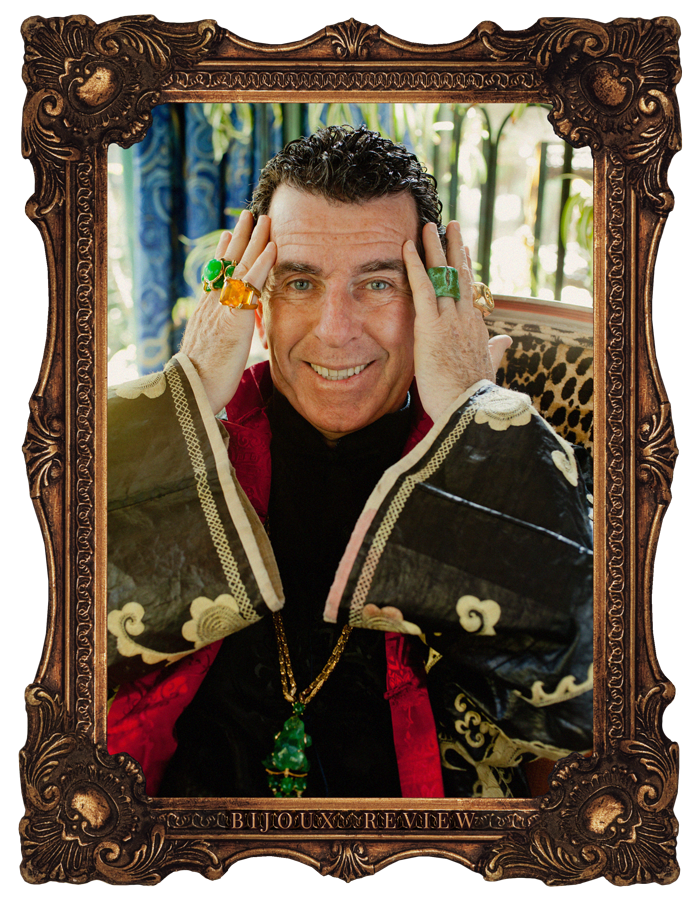
Photo by Sam Yale. Frame courtesy of EKDuncan.
Peek-a-Boo!
According to Hutton, “I walk into a gem dealer and say, “Show me all your stones that nobody wants, the massive, one-of-a-kind gems that most people are wondering about how to set.” He loves organic gems like corals or turquoise that are irregularly shaped, intriguingly carved or massively scaled. Why? “I prize dramatically unique gems just like the person who wears my designs. Luxury jewelry must be one-of-a-kind,” Hutton insists.
Pondering other essentials that define luxury jewelry, Hutton twiddles his “H” and “W” fire opal ring around his finger. “An original artistic vision is a must. I always think conceptually from start to finish,” he says.
“My materials can be flawless gems, rough minerals or organics like pearls or snake vertebrae. Whenever I can,” he relates, “I like using recycled objects to add an extra dimension to the jewels, to make them even more unusual and give them more character.” Hutton’s eye gravitates toward antique carved ivory chess pieces, ancient coral beads and 19th and 20th century gemstone brooches that he dismantles and reconfigures into new bijoux.
“The stones tell me what to do,” Hutton insists. “The stones help me decide on the overall effect and design I am going to create. Skillful integration of materials during the fabrication process is of course essential to the success of the jewel,” he concludes. (Tony Duquette jewelry is fabricated by master jewelers in New York.)
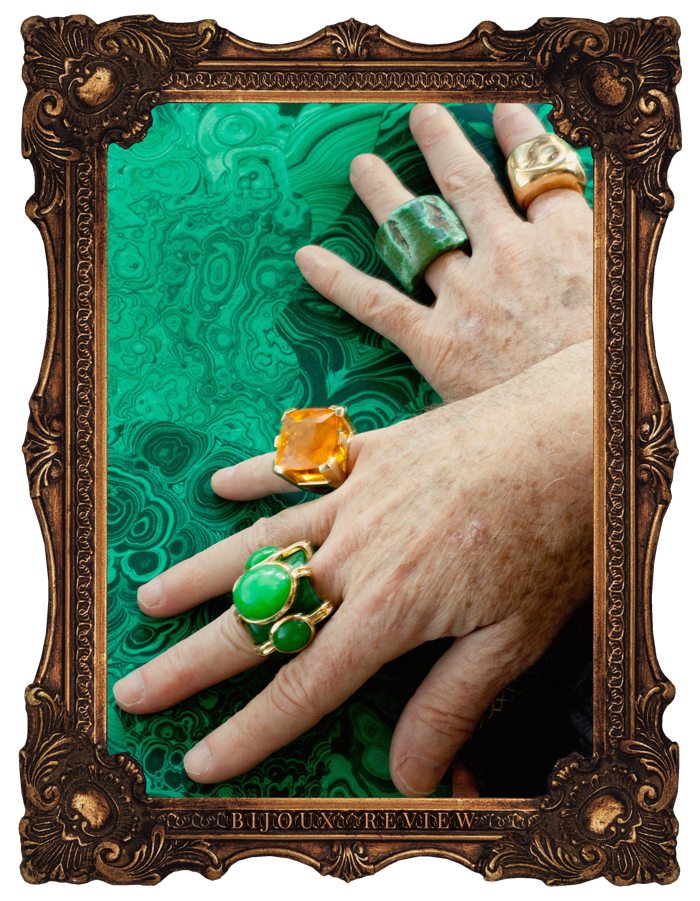
Photo by Sam Yale. Frame courtesy of EKDuncan.
On Hutton’s right pinky finger: the blazing fire opal and 18-karat gold ring’s shanks are shaped into his initials “H” and “W.” To see more rings click www.tonyduquette.com. Hutton also designed the archer’s ring set with three vibrant green jade cabochons in 18-karat gold on the same finger. On Hutton’s left hand, an ancient Chinese turquoise archer’s ring inherited from Tony Duquette complements an 18k gold ring designed by Victoire de Castellane of Dior Haute Joaillerie.
“All my life, I’ve been a freak for malachite,” says Hutton. “I love to design and wear malachite jewels, and of all the stones I use, malachite is the one most associated with Tony Duquette jewelry.” Resting his hands atop a malachite table in the garden room at Dawnridge, he continues, “malachite’s intense green, elegant swirls create marvelous effects. It’s a dreamy stone.”
Tony Duquette was mad for malachite, as well. He designed and wore malachite jewelry and collected malachite objets d’art his entire life.
In case you’re wondering, archer rings are a form of protective jewelry that evolved into de luxe jewels for Chinese Alpha males of the Song and Ming dynasties. These rings allowed the archer to pull back the bow’s string and release it without tearing off the archer’s thumb. Made of jade, turquoise, agate and other stones, these rings became de rigueur jewelry for men of wealth and high status. As in, “Look! This ring renders my hands useless for manual labor…I rank super-high on the Chinese food chain.”
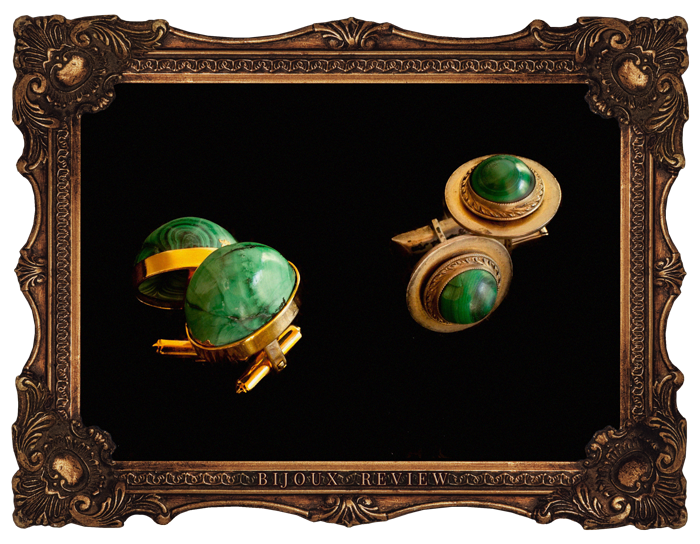
Photo by Sam Yale. Frame courtesy of EKDuncan.
“The first piece of jewelry Tony Duquette made for himself was a pair of malachite cuff links that I now treasure,” says Hutton. (The holy relics rest at right.) Reclining on the left, high-domed malachite cabochon cuff links set in 18-karat yellow gold that Hutton designed for himself.
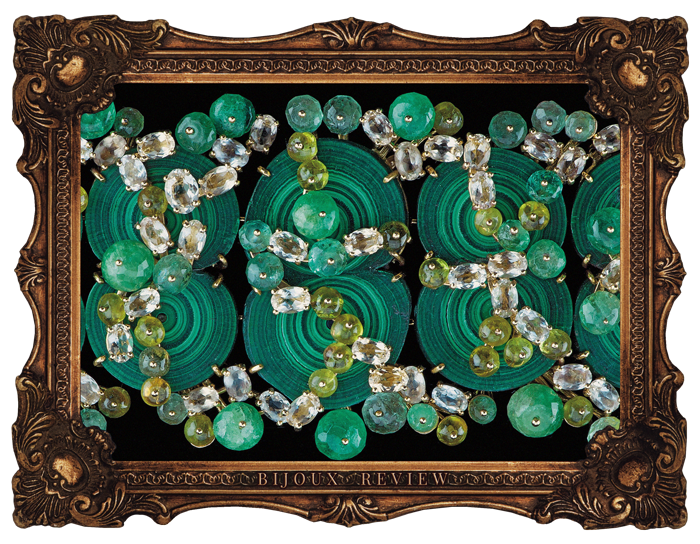
Photo by Stephanie Hanchett, courtesy of Abrams, from Tony Duquette/Hutton Wilkinson Jewelry. Frame courtesy of EKDuncan.
This “Pond Scum” bracelet is part of a necklace, bracelet and earring set based on malachite stalactite slices. Emerald and peridot beads plus faceted citrines glisten like algae atop the malachite’s watery surface. Each stone that glitters in the Pond Scum’s psychedelic stillness nestles in 18-karat gold. This surrealistically styled; singularly beautiful set is one of Hutton’s masterpieces.
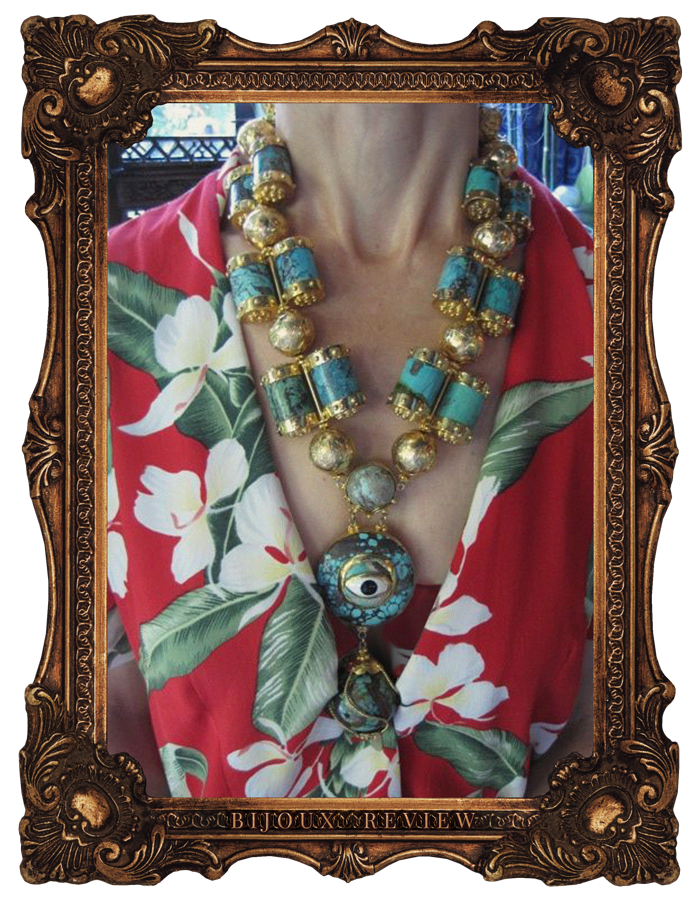
Photo by Sam Yale. Frame courtesy of EKDuncan.
The all-seeing ceramic Burmese Buddha eye adorning this 1980s turquoise beaded Talisman of Power necklace compels you to meet its gaze.
Turquoise cylinders capped with 18-karat gold pieces alternate with substantially sized turquoise beads, creating a dramatically scaled necklace that exudes Bohemian splendor.
Strangely de luxe jewelry like this reminds us how the need to experience beauty is (for many) more basic than comfort. This weighty necklace hangs heavily around the neck, but as VOGUE Japan’s Anna Dello Russo [annadellarusso.com] maintains, “You have to suffer for beauty and fashion. If you’re not uncomfortable, you don’t get the look!”
Hutton agrees that wearing, making, seeing or touching beautiful jewelry can make life feel more magical…thus infinitely more inspiring. “Yes, beauty is more basic than comfort,” he says. “But only for those who understand that gems and jewelry can protect, heal and enchant. A piece of jewelry,” he ventures, “contains stored energy that can transform your life, and the world, with its talismanic powers and your imagination.”
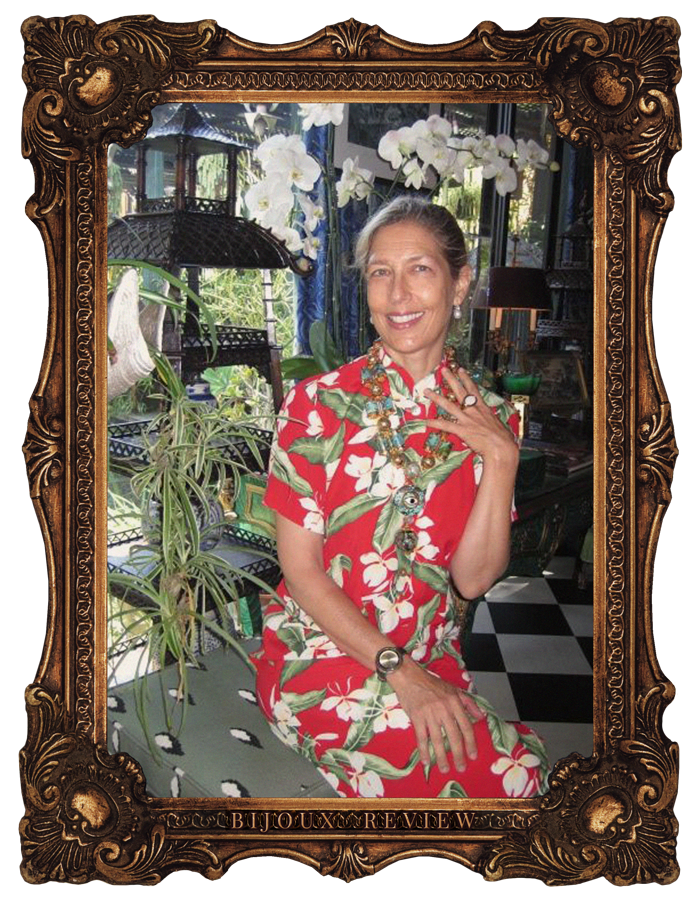
Photo by Sam Yale. Frame courtesy of EKDuncan.
Here I am, tripping on Duquette turquoise and gold-beaded, alchemically chic Cyclops vibes. The necklace feels like a magical amulet and looks like treasure. One of the most perfectly fabricated jewels I have ever enjoyed wearing…and examining.
This coral-skulled, Tahitian pearl, citrine studded and diamond-sprinkled collar mounted on coral branches set in 18-karat gold is Hutton’s version of Memento Mori. Latin for “Remember you must die,” Memento Mori jewelry flourished throughout the grim 16th and 18th centuries, when plagues, childbirth, infections, etc. constantly carried off rich, poor and royalty with democratic dispatch.
Typical Memento Mori motifs include skulls, coffins, crosses, skeletons, roses and vines. These ghoulish adornments emphatically expressed the spiritual imperatives of living a God-fearing life, counting one’s earthly blessings and making the most of every moment.
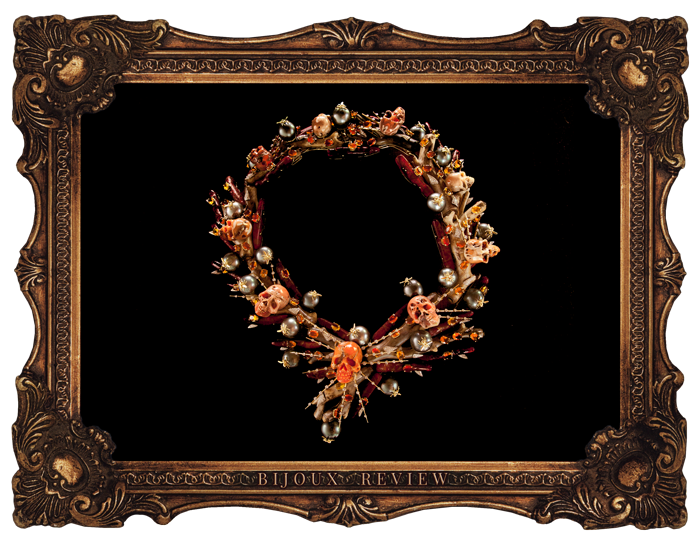
Photo by Sam Yale. Frame courtesy of EKDuncan.
With witty panache and eerie elegance, Hutton’s death glam collar chauffeurs Memento Mori into the 21st century. The workmanship on this piece is exceptional, as the collar sits perfectly on the neck and collarbone and feels comfortably light despite its multiple stones, pearl and coral gems. And dig those 18-karat gold flies adorning the South Sea pearls! For more information, go to www.tonyduquette.com
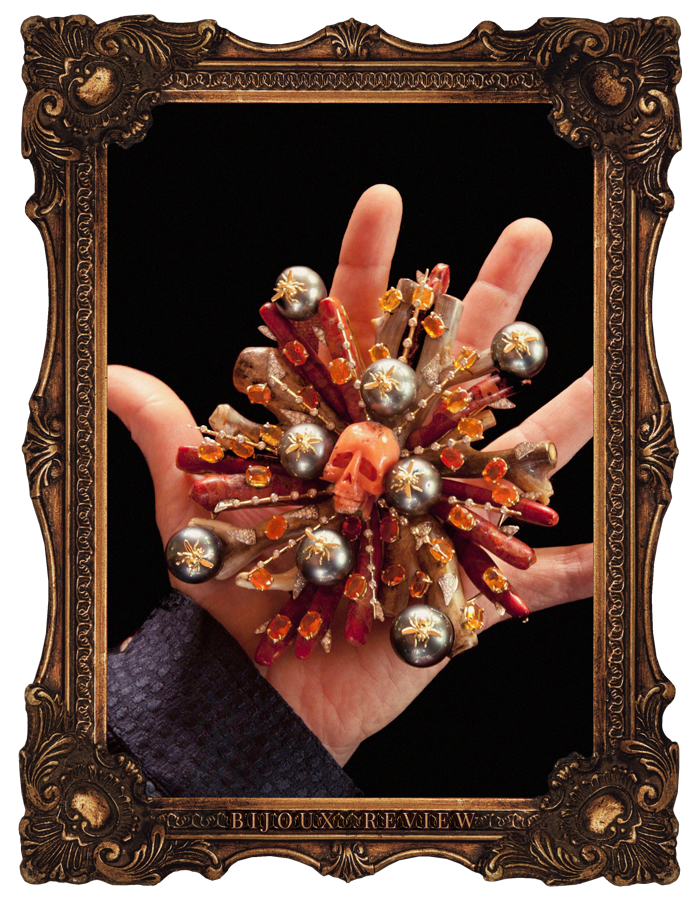
Photo by Sam Yale. Frame courtesy of EKDuncan.
Besides making you look beautiful, this brooch allows the wearer to download and wear the essence of Memento Mori. Jewelry. Hear the ticking hand of time, while Janis Joplin wails inside your mind: “Get it while you can…because we may not be here tomorrow… don’t you turn your back on love.” So get your goblin on…get it while you can!
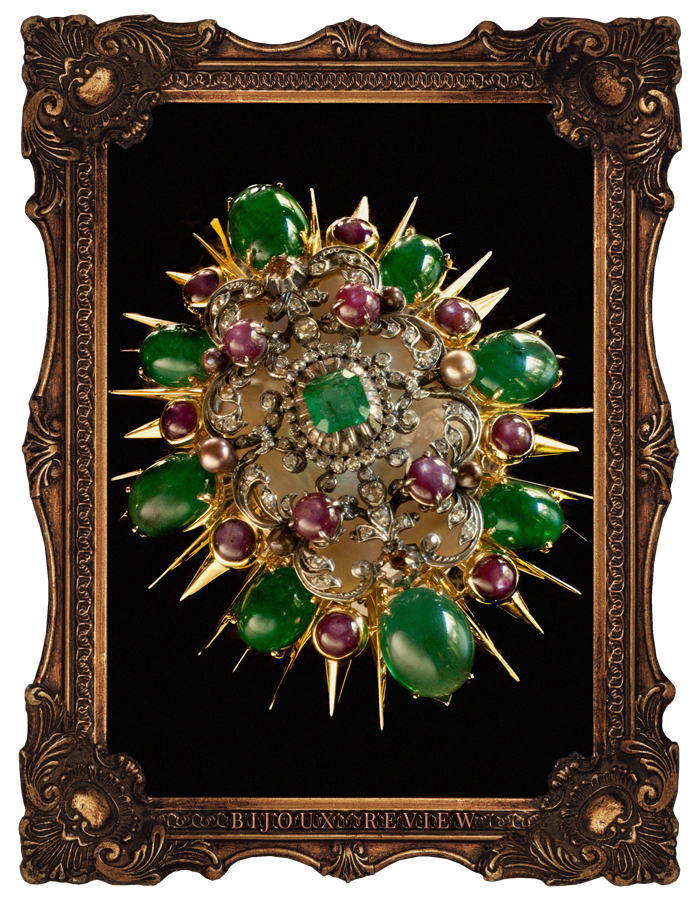
Photo by Sam Yale. Frame courtesy of EKDuncan.
A lifelong upcycler, Hutton often repurposes fine vintage jewelry and various gem materials into new jewels for the Tony Duquette Collection. Here, an Edwardian brooch set with pearls and cognac diamonds inspires a new, gorgeously ornate and masterfully fabricated Tony Duquette brooch.
First, Hutton places a luminous mother of pearl plaque behind the Edwardian brooch to create a romantic, ornate effect. The final layer of this gem delight is a radiant 18-karat yellow gold sunburst studded with luscious star rubies and cabochon emeralds. The resulting jewel is worthy of a Maharani, Maharajah…or you! Ogle oodles of brooches @ www.tonyduquette.com
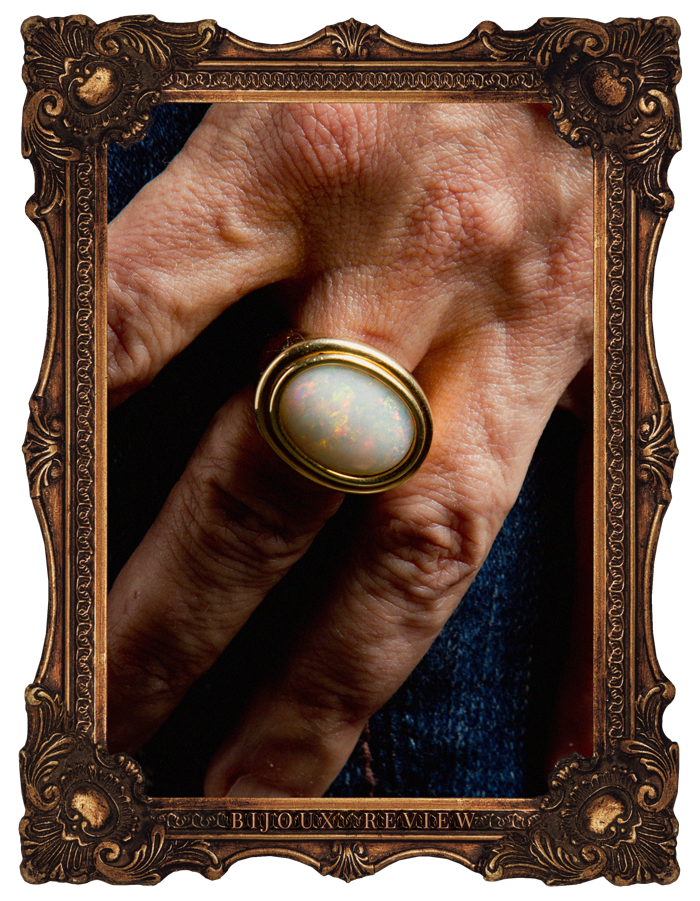
Photo by Sam Yale. Frame courtesy of EKDuncan.
This opal lures you into its Kingfisher blue, lavender, lemon-lime and tangerine depths. Like all fine opals, this one’s color play changes dramatically according to light sources and time of day. One of the most understated rings in the Duquette collection, I liked it so much that I bought it.
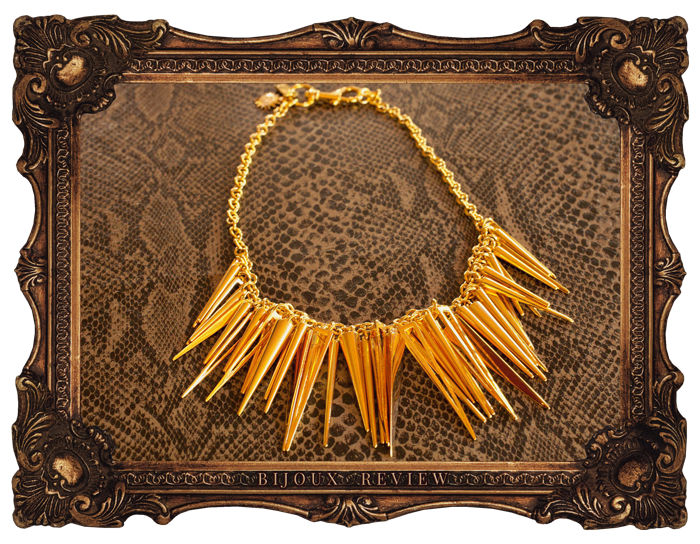
Photo by Sam Yale. Frame courtesy of EKDuncan.
2012 marked the 70th anniversary for both Coach and Tony Duquette Inc. That year, the two companies celebrated with a collaborative limited edition of Tony Duquette costume jewelry for Coach with prices ranging from $65 for stickpins to about $500 for statement necklaces. The collection sold out in a matter of days.
Here’s a Tony Duquette for Coach necklace that survived the shopping frenzy: it’s a classic gold-plated piece. On second glance, however, the golden cones look almost punk. Based on this collection’s smash success, I imagine that Coach and Duquette will team up for another collection.
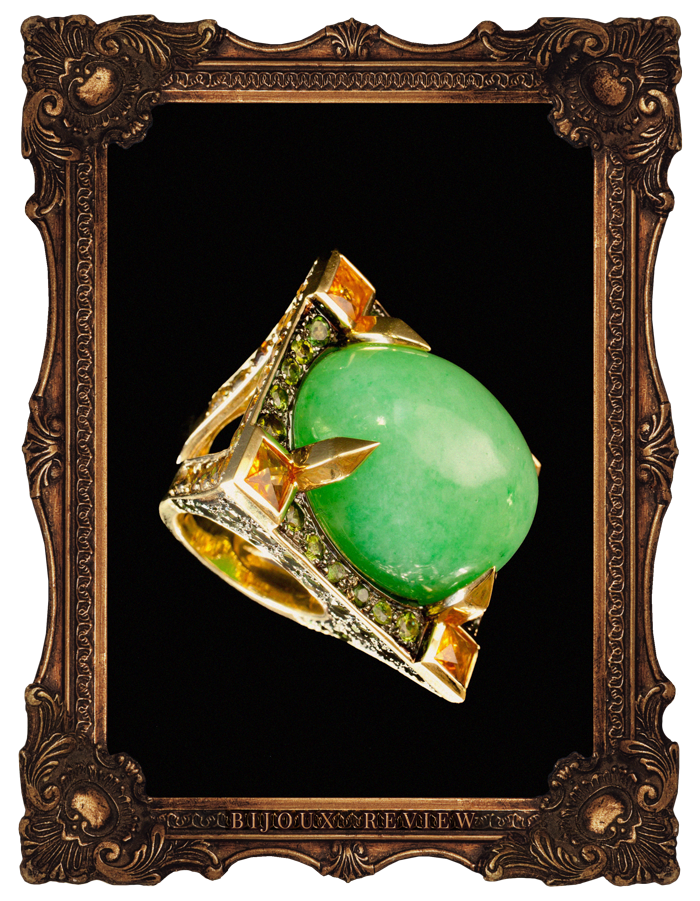
The style of this citrine, jade, yellow and green tourmaline ring is somewhat Hollywood Regency. Instantly messaging Party Power, the jewel is suited to a 21st century fox…or the queen of a galaxy beyond ours! Photo by Sam Yale. Frame courtesy of EKDuncan.
Hutton’s artistic talents and love of fine materials comes quite naturally. Both his father and grandfather practiced architecture.
His maternal grandfather, a.k.a. the Count of Alastaya, was a former president of Bolivia. Pinning on his grandfather’s emerald-studded orders, Hutton paraded around his childhood home with precocious pomp and circumstance. Mesmerized by his mother’s diamonds, pearls, rubies and aquamarines, Hutton spent spellbinding hours bouncing her jewels around the bedspread watching their facets sparkle in the bright Los Angeles light.
BTW, Hutton is the present-day Count of Alastaya, with documentation from the King of Spain to prove it.
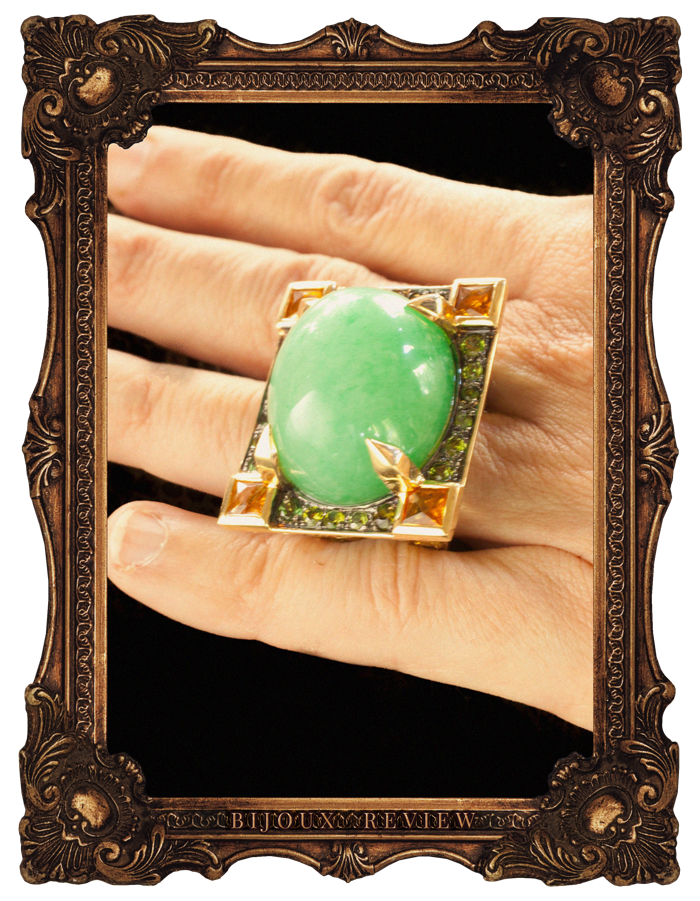
This image provides another view of the Hollywood Regency ring’s design, workmanship and allure. Photo by Sam Yale. Frame courtesy of EKDuncan.
This book is a MUST for Duquette and Wilkinson admirers. Hutton’s text and images by photographer Stephanie Hanchett chronicle Duquette’s “More is More” organically baroque jewelry design ethos, discuss his intense love of visually dramatic jewels while highlighting the cultural history of various gemstones.
The introduction by Glenda Bailey, editor in chief of U.S. Harper’s Bazaar, sets the stage with anecdotes about Hutton’s effervescent approach to jewelry design, gem materials and daily life.
Gilt edged-pages recount how Duquette designed marvelous jewels for his wife, Elizabeth, a.k.a. Beegle and fashion plates like the Duchess of Windsor. Duquette’s many unique contributions to design history include marrying oddly beautiful and/or recycled materials with top grade gemstones and even rough-cut gems with high-karat gold to create otherworldly effects.
Vintage pieces pictured in this book prove that Duquette and Wilkinson pioneered the “statement jewelry” genre decades before the term was coined. Hutton’s refinement of Duquette style through recently designed pieces is amply documented in photos and text.
Click here to buy Hutton’s jewelry book on Amazon.
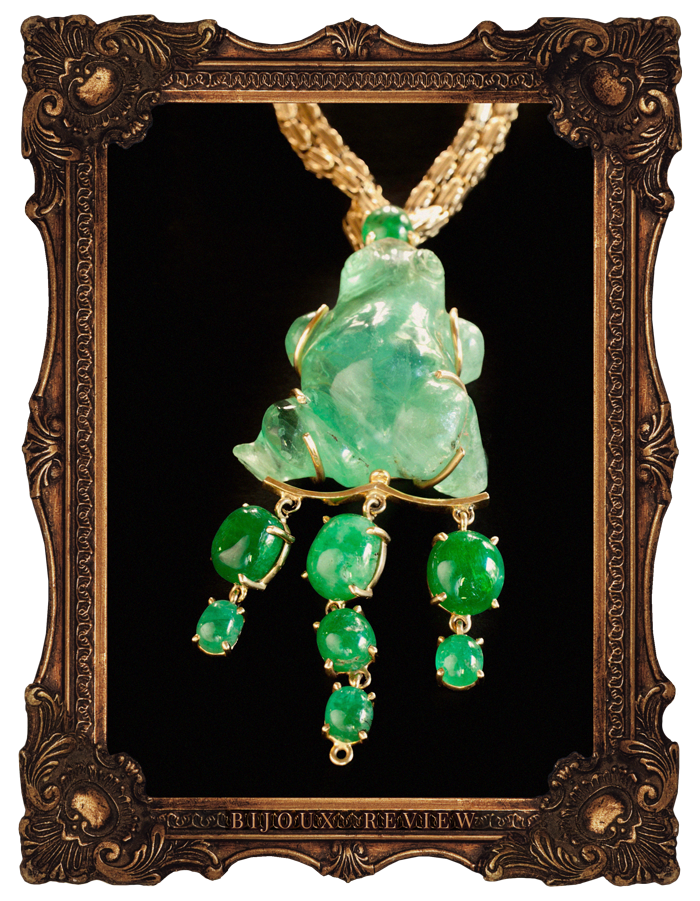
Photo by Sam Yale. Frame courtesy of EKDuncan.
Here’s an 80-carat carved emerald toad, dripping emerald warts on an 18-karat gold braid chain that Hutton wears with his Chinese silk robes. When backed into a gilded corner, Hutton admits that the EMERALD is his favorite precious stone. One of the warts has gone missing. What a beautiful fugitive. This intriguing toad is either a legacy from Tony Duquette or a souvenir from one of Hutton’s gem-buying jaunts. I have forgotten which, as my memory is side-swiped by its beauty.
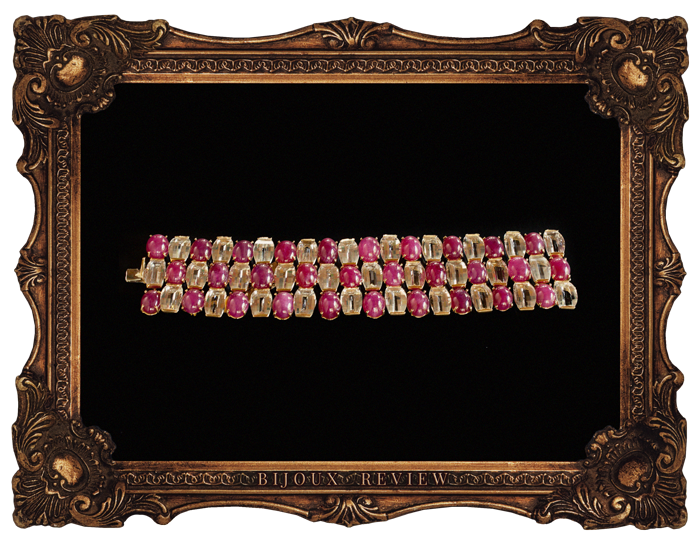
Photo by Sam Yale. Frame courtesy of EKDuncan.
When not designing luscious ruby bracelets like this one, Hutton fulfills residential and commercial interior design commissions for New York penthouses, Southwestern resorts and Southern Californian mega-mansions. A legendary formal event designer, Hutton dreams up everything from beachside weddings in Lyfford Cay, the Bahamas, to Venetian fancy dress balls.
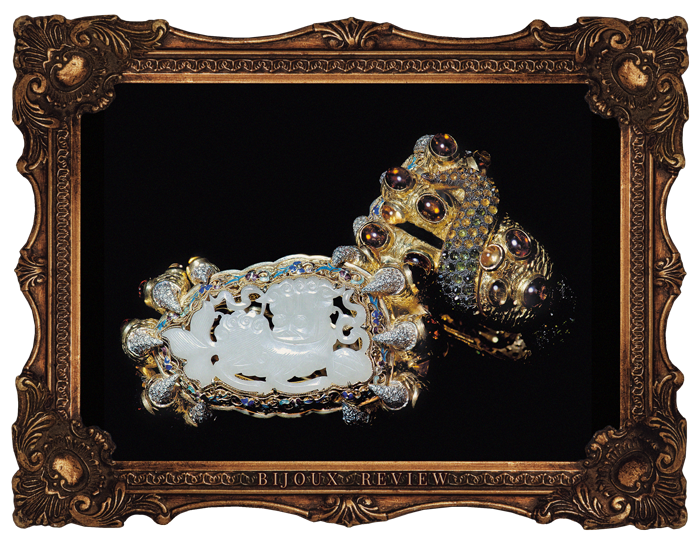
Photo by Stephanie Hanchett, courtesy of Abrams. Frame courtesy of EKDuncan.
While Hutton believes that jewelry should evoke wonder, these cuffs evoke EXTREME wonder. Diamond-tipped dragon talons clutch 18th century carved Chinese jade plaques portraying foo dogs set in their original enameled 18k gold frames. The dragon’s tail wraps around the wrist. Its scales are made of gold, dark brown and green tourmalines set with their cullets facing outward to create reptilian lumps and bumps. Cognac-colored cabochon citrine warts color the chased 18k gold dragon claws. I loved stroking the textured gemstone warts and diamond-studded claws. While these ornate cuffs were way too large, had they fit, I would have considered taking a second mortgage on my house to buy them.
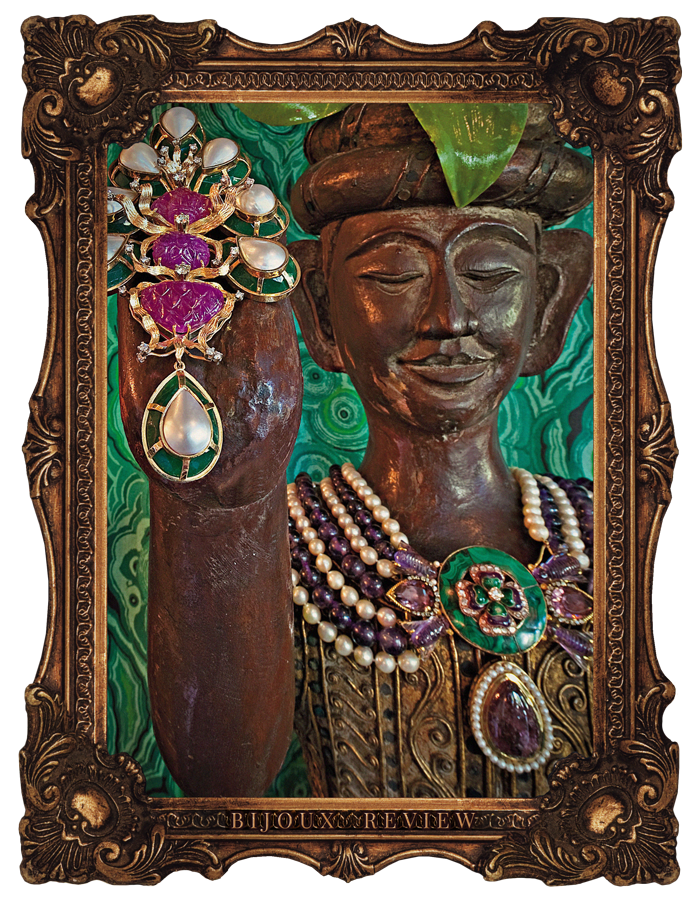
Photo by Sam Yale. Frame courtesy of EKDuncan.
A carved and gilded Thai sculpture holds a dyed green agate, pearl, carved Indian ruby and diamond brooch set in 18k gold. The seven-row pearl and amethyst bead necklace converges in a central malachite, diamond and enameled floral clasp with carved amethyst bees flanking each side. I would love to wear this to the opera. Then again, it would be fun to throw it on and head over to the Farmer’s Market for some early morning vegetable shopping, just to see how people might react.
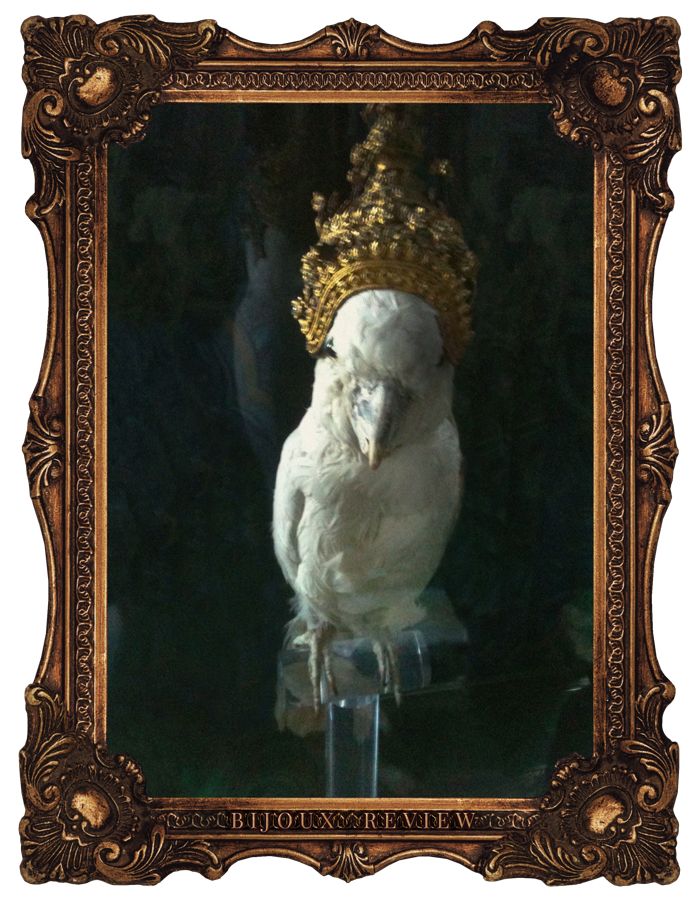
Photo courtesy of Kyle Roderick. Frame courtesy of EKDuncan.
Even the pets wear jewelry at Dawnridge. Here, Eugenie the cockatoo regally rocks a gilded Thai Temple dancer’s hat.
Chillaxing in a beloved 19th century Venetian armchair at Dawnridge, Hutton visualizes audaciously beautiful, important jewelry designs for the Tony Duquette Collection.
Are visions of internally flawless emeralds dancing inside his head?
Perhaps he is dreaming of new Duquette lighting designs for Remains Lighting http://www.remains.com/atelier/
Hutton could also be creating new richly hued patterns for Tony Duquette rugs by Roubini http://www.jodami.com/td/
Or devising fantastic fabric designs for Jim Thompson http://www.jimthompsonfabrics.com/collections/jim-thompson/tony-duquette
Driving Duquette design further into the fullness of time, Hutton adores working on furniture and home decor for Baker http://www.bakerfurniture.com/baker/1_1_1_1_acc_duquette.jsp
Hutton also masterminds delectable malachite, lapis and tortoiseshell-inspired dinner service designs for Mottahedeh https://www.mottahedeh.com/catalogsearch/result/?brand=8&q=Tony+Duquette
Whatever you’re dreaming of Hutton, DREAM ON!
From unpaid teenage apprentice to owning the company…
Your joyfully inspired life and work embraces Duquette design traditions while breathing new life into same.
Bravo…may you continue to raise the bar for de luxe jewelry designs.
BIJOUX REVIEW RATING: on a scale of one to five stars…
The Tony Duquette Collection (drumroll, please):
Design Aesthetic: Since your motto is “MORE IS MORE,” we’re giving you six stars! ******
Choice of Materials/Use of Materials: Your gem materials and metals merit five stars.
*****
Workmanship/Technical Finesse: Keep setting those stones snugly in high karat golds and platinum! Five stars *****
Relative Rarity/Potential Resale Value: As each of your pieces is one-of-a-kind and Tony Duquette pieces fetch relatively high auction prices, five stars are in order. *****


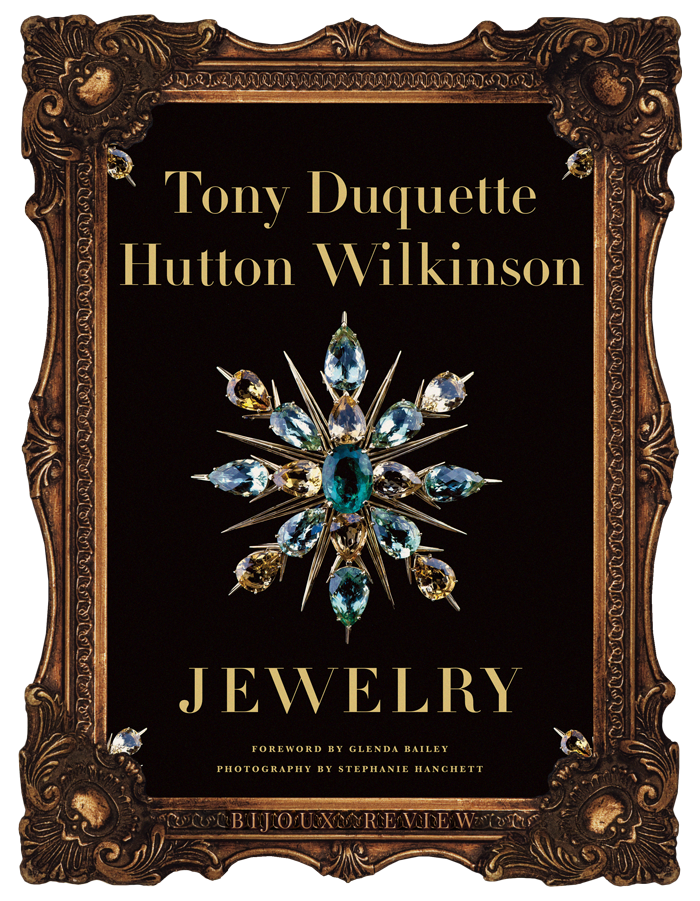
Dear Kyle,
Congratulations on your brilliant new website, and a million thanks for your very generous, and light hearted review of life at “Dawnridge”, and my work. I appreciate your deep rooted understanding of my and Tony Duquette’s aesthetic and relish your enthusiasm for all things beautiful, strange, and inspiring. Your passion for beauty knows no fear, and your curiosity and search for wonder is boundless. Thank you for including me and my work in your fantastic new blog… I am humbled, thrilled, and delighted to be a part of your brave new world. With all best wishes from your devoted, Hutton Wilkinson, Conde de Alastaya
Ahoy Hutton, a.k.a. Conde de Alastaya!
Thank you for the scintillating vote of confidence in http://www.bijouxreview.com. I look forward to seeing evermore important jewelry from you and Tony Duquette…and showcasing it so the world can see, enjoy and purchase some of the wonders that you and your master jeweler create. YOU AND YOUR JEWELS ARE ENDLESSLY INSPIRING.
It is clear Hutton Wilkinson is carrying on the Duquette legacy creating jewelry just as lavish as Tony Duquette’s items were. The jewels are absolutely gorgeous, using the finest of gemstones Mother Nature has to offer. While scrolling these images I felt, in a sense, royal by the creations – extravagant! And his “blinking eye” in the first image, priceless. Keep shining and thanks for this spectacular post. Look forward to the December 5th event. Engage, Inspire, Indulge
Sandie Ward aka The Food Stalker “Where Food and Fashion Collide” http://www.thefoodstalker.com
You are right, Sandie, Hutton Wilkinson’s Tony Duquette jewelry embodies such beauty and grandeur that one feels more human, exalted and perhaps noble, just by looking at it. Oh, and glad you like Hutton’s winking eye!
Great story – by the looks of it more truly is more! (love the eye!)
More is more because less is a bore! Thanks for loving the story as well as Hutton Wilkinson’s wink!
Fabulous!!!!…. As is Hutton…. Simply Fabulous….a dream of a dreamer….
“If it’s not Fabulous, it’s meaningless!” You are a writer’s dream of a reader, thanks for commenting!
Your stylish story is as colorful and brilliant as Hutton and Tony’s jewelry. I have already forwarded it world wide to friends and family.
Terry (Stanfill)
Brava on your positive comment! Thanks for forwarding the story about Hutton Wilkinson’s Tony Duquette jewelry to your friends and family!
Brilliant!
Sparkling!
A Shining story by a Jewel of a writer!
More please!!!!!!!
There will be more, I promise!
I knew Tony Duquette and Hutton Wilkinson when I was a little boy. I think I was vaguely aware that were were business partners, but they were always part of a foursome whenever I encountered them. It was Tony and Beegle (which name prompted constant speculation among my siblings and I), and Hutton and Ruthie.
There were some striking dissimilarities from the many other adults to whom we were exposed. For a young “tween,” the size and spectacular nature of Tony’s rings were the most immediate differentiating feature. I had always been admonished to greet gentlemen with a firm handshake. So the monumental hand-jewelry posed a not insignificant problem. In the interest of avoiding harm to this elderly man’s digits, I began to resort to a sort of semi-bow. The clothing of Mr. Duquette was another distinguishing element. I did not encounter a horde of individuals, in my youth or since, who dressed (as I imagined) in the manner of an Ottoman pasha who had recently returned from a shopping excursion in Thailand, with stops in Polynesia and Paris. By contrast, Mr. Wilkinson was usually attired in a well-fitted suit, sans tie, with a hint of jewelry that might be missed if he were standing in the resplendent orbital zone of Mr. Duquette.
But for me, as a young person who was exposed to a never-ending parade of friends of my parents, the most remarkable difference was the personalities of both men were so overawing compared to that of their wives. I think this was especially noticeably in Tony’s case. Beegle wasn’t a silent person, but nearly so when Tony held court. My imagery memories of Ruthie are dominated by her enduring smile which was, in my experience, ever-present.
I actually didn’t know who they all were or what they did. Just that their visit, several times a year, would be other than ordinary.
When I was 13, I was brought along, with several siblings, to a house that Tony and Hutton (and perhaps Beegle and Ruthie) had transformed in San Francisco. Beegle greeted us on the steps looking rather less than relaxed. Nervous that we would not like it? From the moment I walked into the first room, I was dispelled of any notion that I was embarking on a anything like a normal house-tour. Each room was encrusted from floor to ceiling with shells, jewelry, inlaid furniture, glass, wood, fabric, color, and could not be absorbed with a glance around. It was busy beyond belief while at the same time insisting that every one of the thousands of details was placed with exact precision. Moving from room to room, you could not simply say that you were in the depth of an underwater sanctuary (because the leather cheetah near the chair snarled that you were not)—or that you had magically landed in a Bangkok tea garden (because the French perfume bottle demanded you could not possibly be). At the third room, I understood why the muscles had tightened in Beegle’s face when we arrived. Letting loose all these little brats into her meticulously crafted house—-something was bound to break.
After the Hutton and Tony guided tour (did I mention the ceilings were encrusted with fabulousness and it was too much for them to hold so the fabulousness draped and hung off everywhere?) was over, I felt a tinge of sympathy for them. I couldn’t count how many times they had come for dinner or cocktails in our brick, Georgian home with its white walls and pastoral scenes in green and brown oil paint, with beige furniture, and crown molding. It must have seemed like a padded cell if the home I just toured was their vision of living space.
Later, in my teens, I was taken to visit the Angels exhibition in Los Angeles, and to the building in San Francisco, where Tony and Hutton set up one of their workshops—a building I knew only as the Jim Jones Temple. I saw Tony and Beegle, Hutton and Ruthie at our family farm, where Tony also created a retreat of sorts, from an abandoned farmhouse. By then I had embarked on my own way in the world, and never saw it transformed. That was nearly 30 years ago. The last I saw of any of the four.
So it was with interest that I read the Bijou Review article with its accompanying images. It was fascinating seeing Hutton seated in the fashion of Tony, although with considerably less cacophony of color.
I suppose, for me at least, that is a fitting meld of their styles. And yet, as a parent of an 11 year-old boy who is reminded to look into the eyes of the person with whom he is shaking hands, I wonder how he would negotiate that hand-shake three decades after my own.
Bon chance to Hutton and to Bijoux Review.
Thanks for your poignant memoir of Tony and Beegle and Hutton and Ruth. What colorful reminiscences– they make me smile. I am the mother of three sons who, like yours, have also been trained to look into the eyes of the person with whom they are shaking hands. Two of my sons have met Hutton thus far and both skillfully managed to shake his fire opal, turquoise and gold be-ringed hands without any harm.